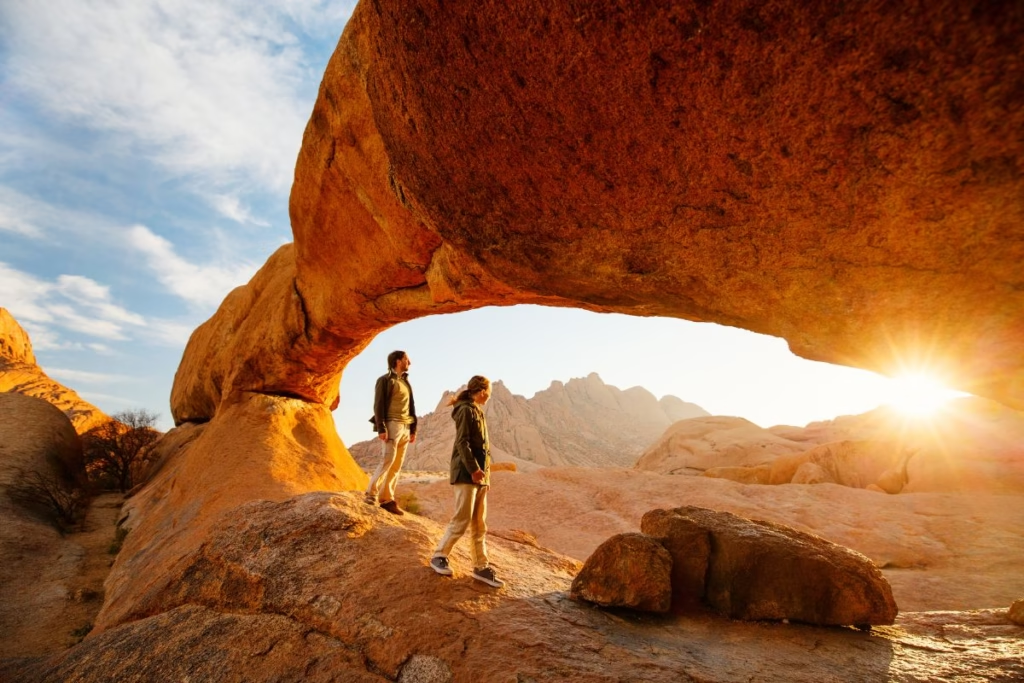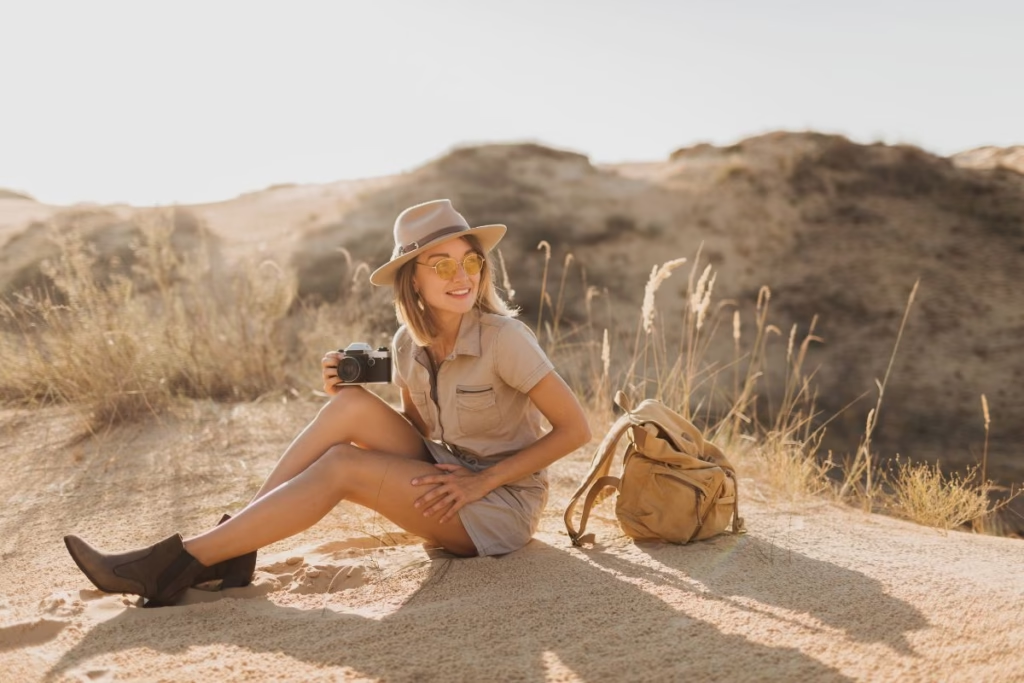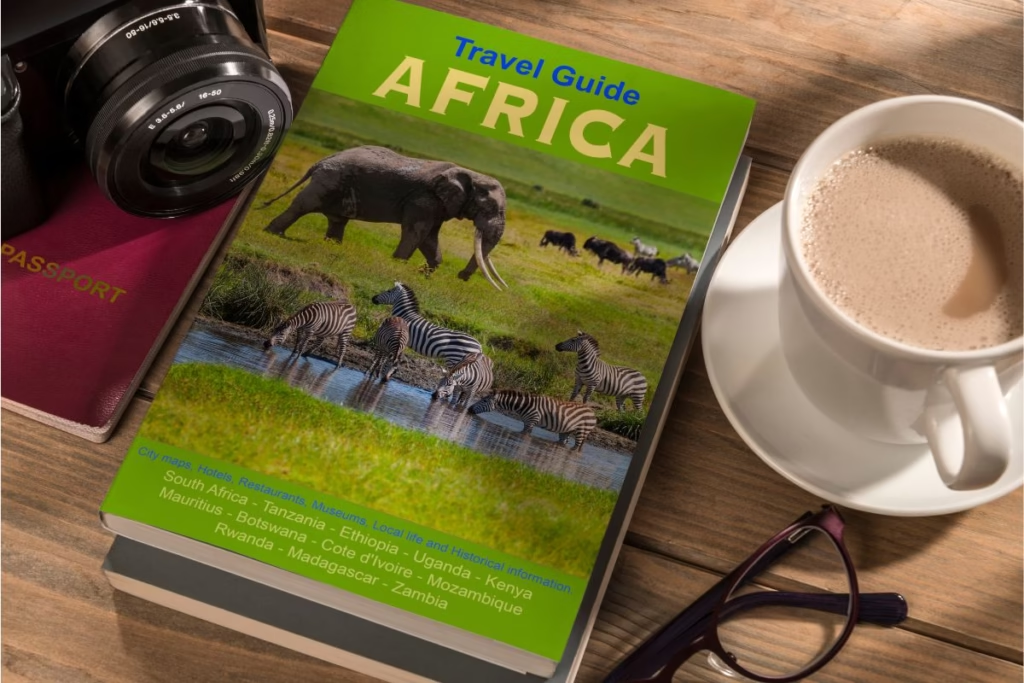Get ready to embark on an unforgettable journey through Namibia, where vast deserts, stunning wildlife, and incredible landscapes await. Packing right is essential for comfort, safety, and making the most of your safari adventure. This guide will walk you through everything you need to pack to be fully prepared for Namibia’s unique terrain and climate with a complete Namibia packing list.
Why Packing Right for a Namibia Safari Matters
Namibia’s wild landscapes range from the sprawling Namib Desert to the lush wildlife reserves of Etosha National Park. When you pack for Namibia, you must consider each area’s unique challenges, from hot daytime temperatures to cool desert nights. A well-planned packing list ensures you’re comfortable, safe, and ready for every experience, no matter the season or environment.
Pre-Trip Planning
Entry Requirements for Namibia
Before you start packing, it’s crucial to ensure you have all the necessary documents for your trip to Namibia. Citizens from countries like the UK, United States, South Africa, Germany, Australia, Japan, and Canada can obtain a 90-day visa on arrival at the airport. However, it’s always best to double-check the visa requirements specific to your nationality. Make sure your passport is valid for at least six months beyond your intended stay, and don’t forget to arrange comprehensive travel insurance. This will cover you for any medical emergencies, cancellations, or unexpected events during your safari adventure.
Weather in Namibia
Namibia’s climate can vary significantly depending on the region and time of year, so it’s essential to pack accordingly. The best time to visit Namibia for wildlife viewing is during the dry season, from May to October. During these months, the weather is generally mild, with temperatures ranging from 10°C to 25°C (50°F to 77°F). However, if you’re traveling during the winter months (June to August), be prepared for chilly mornings and evenings, especially in the desert regions. Coastal areas like Swakopmund and Walvis Bay tend to have a more moderate climate, so pack a mix of warm and cool weather clothing. Always check the weather forecast before your trip to ensure you’re well-prepared.
Clothing Essentials for a Namibia Safari
Lightweight, Breathable Layers
Namibia’s climate can be intense, with scorching midday heat and surprisingly chilly mornings and evenings. Pack lightweight, moisture-wicking clothing that can be easily layered. Breathable fabrics like cotton or bamboo are excellent for keeping cool and dry during the day.
Neutral-Colored Safari Wear
Neutral colors, such as khaki, olive, and beige, not only blend into the environment for better wildlife and game viewing, but also help you avoid attracting insects. Bright colors can be distracting to animals, and darker colors may attract more heat and flies.
Warm Layers for Cool Evenings
Don’t be fooled by Namibia’s daytime heat; desert regions cool off quickly at night. A warm jacket or fleece is essential for evenings, especially if you’ll be camping or staying in open lodges.
Headwear and Sun Protection
With Namibia’s high UV index, a wide-brim hat is a must. A scarf or bandana is also helpful to shield against dust and add an extra layer of sun protection for your neck.
Comfortable, Durable Footwear
Durable, comfortable footwear is essential, especially if your safari includes walking tours or hiking. A pair of sturdy hiking boots will keep you protected on rough terrains, while lightweight sandals are perfect for walking shoes relaxing at lodges. Additionally, packing flip flops is highly recommended for casual occasions such as relaxing at lodges or pools.
Gear for the Safari Experience
Binoculars
National parks are prime locations for wildlife viewing, making binoculars invaluable, especially if you’re on a self-drive safari where you may spot animals from a distance. Choose compact but high-quality binoculars with at least 8x magnification for clear views of Namibia’s remarkable wildlife.
Camera Equipment
For capturing Namibia’s breathtaking scenery and incredible wildlife, a camera with a good zoom lens is ideal. Dust protection is crucial, so bring lens covers and a cleaning kit. Extra batteries and memory cards are a must, as you’ll likely be far from charging stations.
Portable Power Banks and Solar Chargers
Many safari lodges and camps have limited charging options, especially in remote areas. Pack a reliable power bank or a solar charger to keep your devices powered, particularly if you’re taking photos or using a GPS.
Daypack or Backpack
A sturdy daypack is essential for carrying water, snacks, and essentials on long game drives or walking safaris. Look for a comfortable, lightweight design that distributes weight evenly.
Health and Safety Essentials
“Africa is not just a place; it is an emotion, a state of being where the rhythm of life beats in harmony with the pulse of the wild.”
First-Aid Kit
A basic first-aid kit is invaluable. Include items like band-aids, antiseptic wipes, pain relievers, and any personal medications. Be prepared for minor cuts, scrapes, or insect bites.
Insect Repellent and Anti-Malaria Medication
Certain areas of Namibia pose a malaria risk, particularly during the rainy season. Insect repellent with DEET or picaridin is essential, and consult your doctor about malaria prevention.
Additionally, wearing appropriate safari clothing can provide extra protection against insects.
Sunscreen and Lip Balm with SPF
The sun in Namibia can be intense, so bring a high-SPF sunscreen for full-body protection. A lip balm with SPF will help protect against sunburn on sensitive skin areas.
Reusable Water Bottle
Stay hydrated throughout your safari by carrying a reusable, insulated water bottle. Consider a bottle with a filter if you’ll be traveling in very remote areas.
Documents and Travel Essentials
Valid Passport and Visa Requirements
Check Namibia’s visa requirements well in advance. Some travelers may need a visa for entry, so confirm the requirements for your nationality and keep your passport updated.
Travel Insurance Information
A comprehensive travel insurance policy that covers medical expenses, emergency evacuation, and extra cost of safari-related activities is essential. Make sure to have a physical and digital copy of your policy.
Copies of Important Documents
For extra security, bring both digital and physical copies of important documents like your passport, driver’s license, and insurance policy. Store these separately from the originals for added safety.
Tech and Navigation Tools
Offline Maps and GPS Devices
GPS and offline maps are essential, especially for self-drive safaris where cell service can be unreliable. Apps like Maps.me or Google Maps offline mode are great for navigation.
Mobile Phone and SIM Cards
Local SIM cards can provide essential connectivity for calls and data. Network coverage varies, so check which providers work best in safari regions.
Flashlight or Headlamp
For campsites or lodges without much lighting, a flashlight or headlamp is a lifesaver. It’s useful not just for navigating at night but also for spotting wildlife during nocturnal safaris.
Essential Toiletries for a Safari
Biodegradable Wet Wipes and Hand Sanitizer
Wet wipes and hand sanitizer are convenient, especially in remote areas with limited access to water. Opt for biodegradable wipes to reduce environmental impact.
Eco-Friendly Soap and Shampoo
Some safari camps encourage eco-friendly products, especially near water sources. Choose biodegradable soap and shampoo to minimize your environmental footprint.
Tissues and Travel Toilet Paper
Carry travel-sized packs of tissues and toilet paper for use in areas with limited restroom facilities.
Optional Items to Enhance Your Safari Experience
Field Guides and Wildlife Books
A field guide can enrich your safari experience by helping you identify different animals, birds, and plants. Many guides are compact and easy to carry.
Travel Pillow and Lightweight Blanket
A travel pillow and lightweight blanket can be incredibly comforting on long drives and early-morning game drives, especially in open vehicles.
Snacks and Non-Perishable Food
Bring some favorite snacks, especially if you have dietary restrictions. Trail mix, dried fruit, and protein bars are great options for energy on the go.
Luggage Tips
When packing for your Namibia safari, it’s essential to consider the luggage restrictions, especially if you’re taking internal flights. Most domestic flights in Namibia have a luggage allowance of 15 kg-20 kg (33 lbs-44 lbs), so packing light is key. Opt for versatile clothing that can be mixed and matched, and consider packing just 3-4 outfits. Many lodges and camps offer same-day laundry services, which means you can pack fewer clothes and still stay fresh throughout your trip. This approach not only helps you stay within the weight limits but also makes your travel experience more convenient and enjoyable.
Etosha National Park and Camping
Etosha National Park
Etosha National Park is a must-visit destination on any Namibia safari, renowned for its vast salt pans and diverse wildlife. When preparing for your trip to Etosha, pack comfortable and casual clothing suitable for game drives and outdoor activities. Long-sleeved shirts and t-shirts are essential for sun protection and layering, while sturdy, hiking shoes and boots will keep your feet comfortable on rough terrain. Early morning and late afternoon game drives can be quite cold, especially in winter, so dressing in layers is highly recommended. Don’t forget to bring insect repellent to ward off pesky bugs, lip balm to protect against the dry air, and high-SPF sunscreen to shield your skin from the intense sun.
If you’re planning to camp in Etosha, make sure to pack all the necessary camping gear, including a tent, sleeping bag, sleeping mat, and camping stove. You’ll also need utensils, plates, bowls, cups, and cutlery for meal preparation. Always check the weather forecast before your trip and pack accordingly to ensure you’re prepared for any conditions. A well-stocked first aid kit and comprehensive travel insurance are also essential to handle any unexpected situations. With the right preparation, you’ll be ready to enjoy an unforgettable adventure in Etosha National Park.
Eco-Friendly Packing Tips for a Sustainable Safari
Namibia’s natural beauty is fragile, so aim for a sustainable safari experience. Minimize plastic use, bring reusable bags, and opt for biodegradable products whenever possible. Responsible tourism helps support conservation efforts in Namibia’s protected areas.
Final Checklist and Packing Tips
To make things easier, download and print our ultimate Namibia packing list covering each category. Packing strategically can save time and space, so consider organizing items by type and packing only the essentials to keep your luggage light.
Preparing for the Adventure of a Lifetime
With this essential Namibia packing list, you’ll be ready to enjoy the spectacular beauty and diverse wildlife of Namibia. From vast sand dunes to unforgettable sunsets, a Namibian safari is a journey like no other—so be prepared and savor every moment of this incredible experience.








